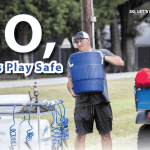Athletic trainers provide medical services to all types of patients in a variety of settings. Most people think that athletic trainers only work with athletes, but that’s not true. Athletic trainers can work for companies like UPS, doctor offices, the Army, schools, and in many other settings as well. As for myself, I am an Athletic Trainer at Banks County High school in Northeast Georgia. I work for a nonprofit company called PlaySafe, based out of Anderson, South Carolina.
The five domains of athletic training:
Athletic trainers improve functional outcomes, educate patients, provide preventable care, and immediate emergency care.
Domain I: Injury/Illness Prevention and Wellness Promotion
Athletic trainers are trained health care professionals with a vast knowledge to care and treat patients. Athletic trainers can promote and assists patients by performing pre-participation physical exams, creating emergency action plans, interpreting environmental conditions, and educating patients. For me, this looks like getting proper warm-ups to my sports teams to prevent injury, making sure everyone has a current physical on file, and knowing my athlete’s medical history so that I can provide the best care possible. I created an emergency action plan for every athletic complex at my school, which is imperative for delivering the best care in case of an emergency. Those are just a few things that I do that relate to this domain.
Domain II: Evaluation, Assessment, and Diagnosis
Athletic trainers examine patients with possible acute, subacute, or chronic musculoskeletal or medical conditions to determine a clinical diagnosis. Our skills include performing a thorough evidenced-based examination, design a plan of action, and communicate with and educate the patient. When kids at my school get injured, they come to see me. I evaluate the injury and decide if it is in my scope of practice. If the injury is in my scope, then I create a plan for the athlete to return to sport. If the injury is beyond my scope, I refer the athlete to the proper physician.
Domain III: Immediate and Emergency Care
We provide immediate and emergency care in the event of unpredictable situations. Athletic trainers are trained in the initial assessment of emergencies. Then activate the emergency action plan if needed while continuing care to the patient. Then communicate our evaluation and treatment with advanced care. For me, this is a rare situation, but I am prepared and ready at all times for these types of situations.
Domain IV: Therapeutic Interventions
We rehabilitate injuries, illness, and general medical conditions to return our patients to sport, work, or any other desired activities. Using evidence-based practice, we apply exercises, modalities, and manual therapies within our scope of practice to achieve the best patient outcome. For me, at the high school, I am returning my student-athletes to sport. I use therapeutic exercises and manual therapy because I do not have modalities. Rehab is an excellent time for me to get quality time with my athletes and support them through returning to their sport.
Domain V: Health Administration and Professional Responsibilities
Athletic Trainers have the skills necessary to create, administer, and oversee healthcare facilities. Accomplishing these tasks requires us to document all medical information, practice within our accrediting agencies, consider quality research, and promote employee well-being. I work for PlaySafe, and I report all the injuries that happen at my school to them. I also attend quarterly meetings and keep in contact with my boss. They are always making sure their employees are happy and have everything they need to provide the best care. I am very thankful to work for this company.
Education:
Currently, to become an Athletic Trainer, one must obtain a master’s degree from a CAATE accredited university. Upon graduation, pass the Board of Certification Exam and acquire a license in the state in which they will be working. Throughout the career of an Athletic Trainer, they must complete Continuing Education Units to stay up to date on new information.
Sources: NATA
Blog information by: Zoey Forrester ATC – Banks County High School





